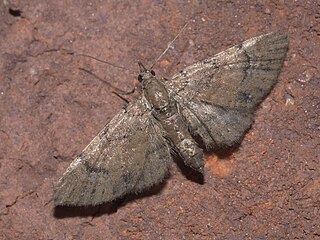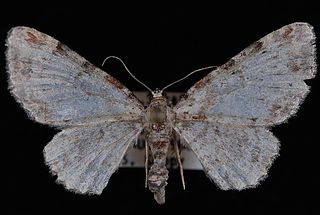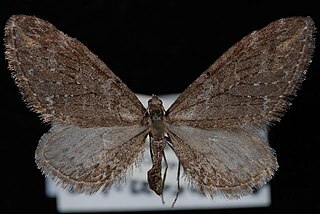Eupithecia insolabilis is a moth in the family Geometridae first described by George Duryea Hulst in 1900. It is found in the southern United States, including Utah, Arizona and New Mexico.
Eupithecia catalinata is a moth in the family Geometridae first described by James Halliday McDunnough in 1944. It is found in the southern United States, including Utah, Arizona and New Mexico.

Eupithecia peckorum, or Peck's pug moth, is a moth in the family Geometridae. The species was first described by Roger L. Heitzman and Wilbur R. Enns in 1977. It is found in the United States in eastern Texas, Missouri, Mississippi and Louisiana.
Eupithecia nabokovi is a moth in the family Geometridae first described by James Halliday McDunnough in 1946. It is found in the US states of California, Arizona, New Mexico, Utah, Colorado and Wyoming.

Eupithecia cimicifugata is a moth in the family Geometridae first described by Pearsall in 1908. It is found in North America, including Alberta, Ontario, Saskatchewan, Kentucky, Maryland and South Dakota.
Eupithecia nimbosa is a moth in the family Geometridae first described by George Duryea Hulst in 1896. It is widespread in the Rocky Mountains, from Arizona to the Canada–US border.
Eupithecia flavigutta is a moth in the family Geometridae first described by George Duryea Hulst in 1896. It is found in the United States in Colorado and montane forest areas in eastern Arizona and south-western New Mexico.

Eupithecia mutata, the spruce cone looper or cloaked pug, is a moth in the family Geometridae. The species was first described by Pearsall in 1908. It is found in the northern Atlantic and New England states in North America. In Canada, the range extends from Nova Scotia to northern Ontario.
Eupithecia hohokamae is a moth in the family Geometridae first described by Frederick H. Rindge in 1963. It is found in the United States in southern Arizona and California.

Eupithecia affinata is a moth in the family Geometridae first described by Pearsall in 1908. It is found in North America, including Pennsylvania, New Jersey, New York, Maryland, Maine, Michigan, North Carolina, West Virginia, Kentucky, Ontario and Quebec. It has also been recorded from Arizona and California.
Eupithecia quakerata is a moth in the family Geometridae first described by Pearsall in 1909. It is found in the US states of Colorado, Utah, New Mexico, Arizona and California.
Eupithecia piccata is a moth in the family Geometridae first described by Pearsall in 1910. It is found in the US states of Arizona and New Mexico.
Eupithecia exudata is a moth in the family Geometridae first described by Pearsall in 1909. It is found in the eastern United States, including Pennsylvania, Indiana, Kentucky and Ohio.
Eupithecia biedermanata is a moth in the family Geometridae first described by Samuel E. Cassino and Louis W. Swett in 1922. It is found in the US state of Arizona.
Eupithecia segregata is a moth in the family Geometridae first described by Pearsall in 1910. It is found in the US states of Oregon, Arizona and California.

Eupithecia scabrogata is a moth in the family Geometridae first described by Pearsall in 1912. It is found in western North America from British Columbia to California and Arizona.
Eupithecia adequata is a moth in the family Geometridae first described by Pearsall in 1910. It is found in the United States from Utah and Colorado through Nevada to California and Arizona.
Nasusina vaporata is a moth in the family Geometridae first described by Pearsall in 1912. It is found in the United States in southern California, Nevada and probably Arizona.
Prorella insipidata is an American moth of the family Geometridae first described by Pearsall in 1910. It lives in Oregon, California, Arizona, New Mexico and Texas.
Prorella opinata is a moth in the family Geometridae first described by Pearsall in 1909. It is found in the US states of Colorado, California, Arizona, New Mexico and Utah.




